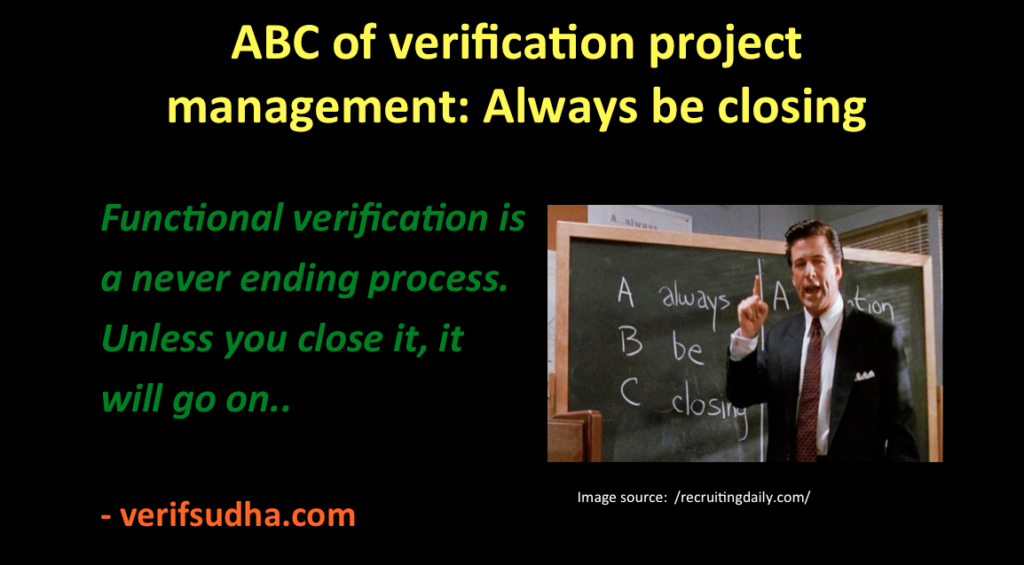Verification project management
Verification project management is a set of process and principles to achieve high quality verification results. These process and principles are anchored around six essential…
Verification project management is a set of process and principles to achieve high quality verification results. These process and principles are anchored around six essential generic parameters. Six essential generic parameters are Clarity, People, Metrics, Tracking, Review and Closure. Verification project consists of primarily three phases. They are planning, development and regressions. All six essential generic parameters are applicable to all three phases of verification.
This article is organized as:
- Brief introduction to six essential generic parameters
- Brief overview of three phases
- Brief introduction on people management
- Brief introduction on role of Verification manager
- Applying these managmement concepts in all three phases
Six essential generic parameters :
- Clarity: Identifying the aspects that should be clear. It can be clarity of goals, tasks, timelines and process. Clarity is not absence of ambiguity but a constant battle against the ambiguity. This is a single most important factor that keeps team motivation levels up and translates to results.
- People: Right person for right job is half the job done. Bad engineers are rare. Most are just mismatches in assignments.
- Metrics: Management guru Peter Drucker quoted “If you can’t measure it, you can’t manage it”. Metrics provide indication of how the project execution is progressing. Right metrics provide insights to improve the execution.
- Tracking: Tracking is a process of collecting metrics and using metrics to tune the processes to achieve the desired results. Tracking provides the push required for closure.
- Review: One of the popular Russian proverb says “Trust, but verify”. Review is a process to guard the quality in each of the tasks to achieve overall quality goals.
- Closure: ABC of verification project management is “Always be closing”. Functional Verification is never ending process. Unless you close it, it will go on.

Three phases of the verification project:
The three major phases of the verification project are planning, development and regressions.
- Planning phase primarily focuses on creating verification plan and test bench architecture. Verification plan consists of test plan, checks plan and coverage plan. Based on verification plan and test bench architecture detailed task lists are created.
- Development phase focuses on building the bus functional model(BFM), test benches and tests. HVLs and Verification methodologies play a major role in building these.
- Regression phase is about executing all tests and its variants to catch the issues and meet the coverage goals.
These phases do not have very precise boundaries. Only the focus moves from one phase to another during project cycle. The phase under focus gets more attention and resources.
Planning phase gets highest attention during the initial part of the project. Planning activity mostly completes about 70-80 % during planning phase. Remaining part of planning activity completes within first 50 % of the development cycle.
After the initial planning phase completes, the verification project execution is divided into multiple milestones for making feature verification time bound. Every milestone starts with brief planning activity mainly consisting of scheduling of tasks subsequently it’s dominated by development and regression phases. Milestones early in verification project are development dominated and towards end it’s dominated by the regression phase.
People management
People management aspects are not covered in detail as part of this article. This is the only paragraph on people management aspects. Quoting some of points from Dan Pink’s TED talk on puzzle of motivation. Extrinsic motivation works great for left-brain tasks made up of clear set of rules and have a single solution to problem. Functional verification does not fall in that category. It does not mean there aren’t any tasks of this nature. But it’s dominated by the tasks that require some level of creativity and ability to deal with ambiguity.
Extrinsic motivators of the type carrot and stick alone cannot provide results. Management is for compliance. Self-direction is for engagement. New age mantra for driving teams is to create environment of autonomy, mastery and purpose.
Ending this topic, by quoting Sahil Gupta, aspire to be a leader whose legacy is not just the products delivered but also the teams created. These form principles for people management.
Verification manager
Verification manager plays a key role in the verification project management. Look at the composition of the successful verification teams to understand the roles and responsibilities of the verification manager further.
One of the key responsibilities of the verification manager is to define, refine and improvise process to achieve sustained high quality verification results. We have developed a framework to help you do a quick audit of your constrained random stimulus. This will help you make your stimulus work hard for you and helping you meet your verification quality goals.
Take care of process and results will take care of themselves. – MS Dhoni (Captain of Indian cricket team)
Project manager is an owner. An owner who needs to ensure the quality of the verification meets the requirements and results are delivered in time. Project should not be organised around project manager. Project manager should organise project around sound principles and processes.
There are multiple phases of the verification project. Each phase has it’s own challenges. Each phase has it’s own of best practices suitable for it. Each of the generic essential parameters identified should be viewed in the light of requirement of verification project phases. Be it tracking, metrics used, reviews conducted, follow up styles should be adapted to meet the objective of respective phase.
Inspite of all the efforts some times its challenging to meet the verification quality goals. Our services can help you quickly spot the coverage gaps in your constrained random verification.
Let’s now look at how to apply six essential generic parameters in each of the planning, development and regression phases.